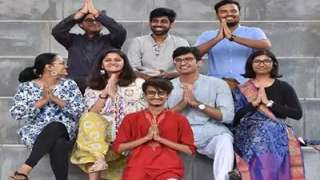MEDIA
#DetourIndia: A journey to discover the country
www.timesofindia.indiatimes.com | April 5, 2020
Second year undergraduate students from FLAME University, as a part of the Discover India Programme, set off on a journey to travel, explore and learn about various parts of Indian the month of February . The idea was to get a first-hand experience of the culture, art, people, and food of different regions of the country. Under the programme, students got the opportunity to get experiential learning and a strong research ethic. “The Discover India Programme helped them find out something new and interesting about a place and its people, which hasn’t been explored or much written about. It was a way to expose them to the enormous amount of learning that happens off-campus, teach them academic values, group work, leadership, cooperation, using the limited resources wisely, etc,” says Professor Kunal ray, Chair of the Discover India Programme, FLAME University.
An ode to truck artistes
Bright caricatures and catchy punchlines written on trucks have caught everyone’s fancy, most of us remain ignorant about its origin.
Second year student Kushal Shah whose project was based on truck art and lives of truck drives in Indore, says, “There is a lot of research done on truck art in countries like Nigeria, Japan, United States, and Pakistan, but in India, there’s no detailed research on the art form, so we thought of taking it up. He adds, “A truck driver’s life is very difficult, and he spends most of the time on the road, so most of the truck drivers ask the artists to paint things on the truck that are reminiscent of their home. For example, their village or pictures of their family. The truck is not just a vehicle but their homes moving with them.” says Kushal. Brands use truck art to make their products/merchandise attractive, but don’t give the artists enough credit. “From notebooks to bags, coaster and even Bollywood posters take inspiration from truck art, but no credit is given to the creator of the art,” laments Kunal.
Calligraphy of Ajmer
Secons year student Palak Jain’s group visited Ajmer to study Sufism. At a time when there’s religious conflict becoming a pressing issue in the country, Ajmer in Rajasthan, a Hindu inhabited city, is famous for its Sufi Dargah. Talking about Urs, a 6-day event which was held in Ajmer Sharif in March, Palak says, “Urs is observed to mark the death anniversary of Khwaja Moinuddin Chisti. Apart from devotees visiting the dargah during this time, calligraphers across India, too, visit the dargah annually to participate in the calligraphy competition that happens at the Mehfil Khana. The idea is to promote this art form.” The descendant of Khwaja, Salman Chishti who is now the chair of the dargah took the group to his library which houses the winning pieces of the calligraphy work
Apart from being known for Ajmer Shariff, Rajasthan is shopper’s heaven, “From jhumkas, tp dupattas and beautiful mojris, we bought these at a pocket-friendly price,” says Palak.
The unique cocoon auction of Ramanagra
For student Sathvik Bharadwaj going to Ramanagra, known as silk city, was like finding answers to questions which he had about the city. Located on the Bengaluru-Mysore Highway, Ramanagra, despite being one of the largest exporters of silk, an expensive fabric, in Asia, remains a humble city with people leading a simple lifestyle. However, the daily auction of cocoon makes the city unique. “The auction happens every day except Independence Day and Republic Day. It kicks off at 10 am, where the cocoons are brought, and the government officials first run a quality check. It is followed by reelers picking up the cocoons in their hands to examine and decide the price at which they will be sold to the dealers. There are 1088 silk reelers in the city, despite that, the city is a lazy, sleepy town,” says Sathvik. Besides, sericulture, the fact that the film Sholay was shot here, it makes the city interesting. However, it isn’t a full-fledged tourist destination. “People don’t come here much,” says Sathvik, adding, “Despite being a big exporter of silk, there are no saree or dress material stores in Ramanagar because weaving doesn’t happen here as both the tourism and market is low. Hence, Bengaluru and Mysore are the spots where weaving and trade happen,” explains Sathvik.
Chandni Chowk is history on the plate
Student Siddharth Khare and his group went to Delhi’s Chandni chowk to study the age-old food community there. Siddharth explains, “It’s the quality and authenticity that brings people here again and again. And our question was how can a place which is as old as 100 years, maintain the same quality and taste? A 1950 eatery owner informed us that the recipe hasn’t changed since the time they started the place, in fact, the pots also remain the same. The technique of cooking hasn’t changed either.”
The oldest eatery Ghante Wala in Chandni Chowk is 300 year old, while the newest restaurant in the area is about 80-year-old. Some of the famous shops in the areas are Chena Ram, Kake Di Hatti, Gyani’s, Pandey Ki Lassi. “While the history of the place is rich, the food is quite budget-friendly. A big portion of daal which is enough for four people cost us just Rs 300. So, Chandni chowk, is beyond just food, it’s like history on the plate,” says Siddharth.

